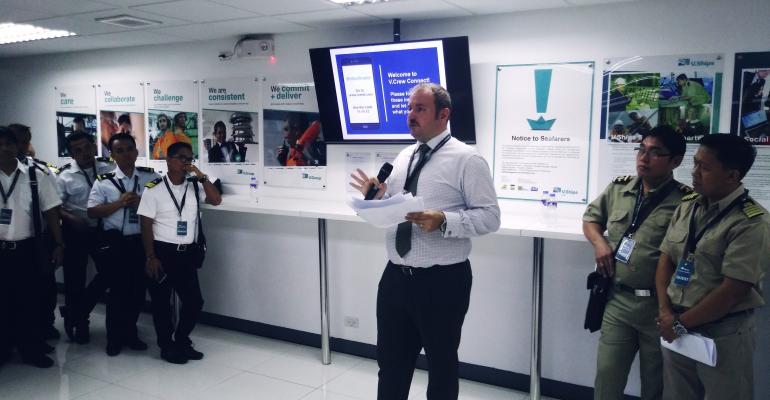With over 1,700 vessels with 25,000 crew on board at any one time and 44,000 seafarers on its books V.Group is aiming it says to transform the crewing industry through the digitalisation and integration of the seafarer experience at the core of its services.
Gathering over 60 guests, comprising industry representatives, media and its own seafarers, at its training centre in Manila last week, V.Group set out an ambitious plan to integrate all aspects of the seafarer experience via mobile platform, with a standardised product delivered on a global basis.
Called Project Embark V.Group took the brave step to unveil its innovations before they are fully up and running across its global business, even if the system has been under development for some time now.
Allan Falkenberg, group managing director, crew management at V.Group, explains, “Embark itself has been quite a journey it started in 2017 and we’re going to transform the crewing industry. We see seafarers as an integral part of how we deliver of our services.”
Seafarer app
At the core of this is a seafarer app – V.Crew Connect - currently in a pilot phase with about 80 seafarers, which is designed to link the individual from the phase of looking for an assignment all the way to disembarkation and necessary communication while on leave with family and friends. Or “cradle to grave” as one executive described it.
V.Group executive David Higgins says, “As a community we’ve got used to a digital capability, why can’t we give a seafarer that experience? Currently seafarers have a very fragmented experience.”
The seafarer will be notified of new assignments, which can be accepted or rejected via the app with the contract signed digitally. They will be able to track mobilisation details and upload required documents, and when the contract is coming to an end view disembarkation details and travel arrangements.
One of the things the company identified was that seafarers had to go through multiple layers even with a single employer and the app aims to streamline this process and reduce the number of trips to the office, which can often be many hundreds of miles away from where the seafarer lives.
“For a seafarer instead of a journey to the office they can perform lot of the tasks electronically,” explains Simon Frank director crew operations East for V.Ships.
With ship-to-shore connectivity the seafarer will also have greater access and transparency over such as payroll with the ability to perform tasks such as monetary transfers without having to go via the Captain of the vessel.
Utilising AI in deployment
From the point of view of the customer of V.Group the system will bring together what is currently a fragmented, regional system in terms of matching available crew with vacancies on vessels. Higgins explains that crew were in quite localised pools meaning that as global organisation they were not fully tapping into the worldwide resources available.
The company now plans to artificial intelligence (AI) through a system called ShipSure which will bring together the 44,000 crew across 1,700 vessels, over 300 customers, vessels movements and constraints to optimise crew deployment.
While the app enables a digital experience for the seafarer in terms of interacting with their employer there are also physical investments and assets for when crew do need to come to the office for training or other reasons.
Seafarer centres
The company has some 30 seafarer centres it is developing across the globe to improve the experience of the seafarer when they come to the office to meet with senior shore staff.
Andy Cook, V.Group’s global crew operations director, explains that it will be “a bit like a business class lounge”.
It in a system that is somewhat similar to say a mobile phone shop the person the seafarer needs to see will come to them rather than the seafarer having to wait to go to an office or a desk. “When they come into the seafarer it is about the relationship,” Cook says.
Of course nice surroundings do not really help if you are just left around waiting and V.Group says that all queries will be tracked with it ensured that that they are closed or resolved.
Training facilities
The company is also invested substantially in training facilities which in Manila cover all aspects from the bridge and navigation, to the engine room, to the galley and catering. The newest addition is a high voltage simulator a response to the high voltage power supplies used on large, modern vessels such as containerships with large numbers of reefer points.
For the app at the core of Project Embark it will be rolled out to 3,000 Indian seafarers in December, something that should start to really test the capacity of the system. Then the plan is to give all V.Group’s 44,000 seafarers globally access to the system next year.

High voltage simulator
Copyright © 2024. All rights reserved. Seatrade, a trading name of Informa Markets (UK) Limited.
Add Seatrade Maritime News to your Google News feed.  |


